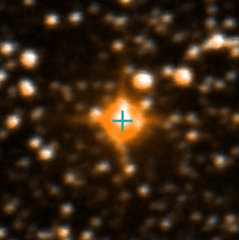Star of the Month
Chi Cygni
AKA: Khi Cygni
Position: 19 hrs 50 min 34.9 sec +32 degrees 54 min 51 sec
Chi Cygni
Image: Simbad (http://simbad.u-strasbg.fr/simbad/)
Chi Cygni is a Mira-type variable which is about 590 light years away and, like Mira (see Star of the Month for November 2019), you either see it or you don’t. It shows one of the largest variations of any pulsating variable star, ranging from 4.8 which is naked eye brightness in favourable circumstances to a minimum of around 14. However there is considerable variation in both the maximum and the minimum. The period is also variable, but is about 408 days and may be slowly increasing. The rise is typically faster than the decline. Chi Cygni peaked at 4.9 on 1 February 2020 and reached its minimum around 15 September 2020 at magnitude 13.4. It peaked again at 4.6 (which is unusually bright for recent maxima) on 16 March 2021.
If you have read about Mira or other variable stars in this Star of the Month series, it will not surprise you to hear that Chi Cygni is a red giant. It is an elderly star and is currently in a rather bad way. It has exhausted its core helium and is currently surviving by burning hydrogen and helium in concentric shells, rather like the skins of an onion. It is on the asymptotic giant branch of the Hertzsprung–Russell diagram or an AGB star. This means it lacks good temperature regulation: its radius regularly expands and its temperature drops at the same time. Its luminosity is a function of its radius and its temperature, so at the point where its radius is shrinking but the temperature has not yet caught up, it becomes dimmer. Conversely when its radius is expanding but the temperature has not yet cooled very much, it is much brighter.
The main interest of Chi Cygni apart from its extreme variability is that it was one of the earliest variables to be discovered. Johann Bayer designated the star as Chi Cygni in 1603 presumably when it was near its maximum. While looking for Nova Vulpeculae (discovered by Johannes Hevelius in 1670), the astronomer Gottfried Kirch noted the variability of Chi Cygni in 1686 and believed it was a regular variable with a period of 404.5 days. The variability of its maxima/minima and its period were first noted in the nineteenth century. You can find Chi Cygni roughly half-way between Sadr (Gamma Cygni; mag. 2.2) and Albireo (Beta Cygni; mag. 3.4) and about a quarter of the way between Eta Cygni (mag. 3.9) and Albireo. You can spot it to the side of a right-angle triangle formed by 17 Cygni (mag. 5) and two sixth magnitude stars. So if it is brighter than 17 Cygni, it is near its maximum, but it is unlikely to be as bright as Eta Cygni. On 15 March it will be visible about midnight but fairly low in the eastern sky. The next maximum is around April, when it will be higher in the eastern sky at midnight.
